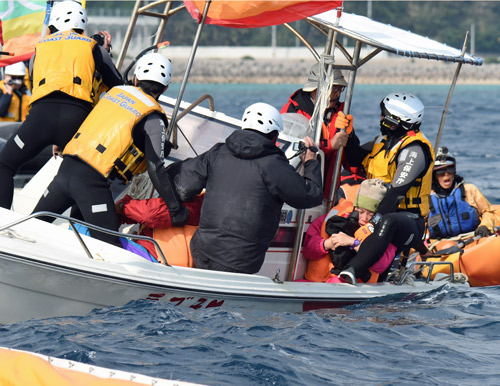Coast Guard officer takes excessive action against female citizen: Japanese government cites safety measurement

A coast guard officer put his leg on Kageyama's shoulder and held her body down with his weight(three from right). Several people, including coast guard officers gathered on the stroke side, making the ship body lean toward the left. In Oura Bay in Nago at 2:35 p.m. on January 20 (Photographs taken by Takaya Kinra).
January 31, 2015 Ryukyu Shimpo
Fifty-one-year-old female filmmaker Asako Kageyama was on a ship protesting against the plan to build an alternative base in Henoko, Nago, for Ginowan-based U.S. Marine Corp Air Station Futenma. A coast guard officer took excessive action against her by putting his leg on her shoulder and holding her body down with his weight. Akihiro Ota, the minister of land, infrastructure and transportation claimed the coast guard office did so to secure the safety of Kageyama on the overloaded ship. However, the ship was overloaded with passengers because too many coast guard officers boarded it. The ship ended up swaying. What the coast guard officers did in the name of “securing safety” put the passengers in danger. The explanation by the minister contradicts what actually happened. The explanation by the Japan Coast Guard (JCG) changed repeatedly, lacking consistency. It prompted a protest from citizens.
At the budget committee meeting of the lower house in the Diet, held on January 30, Seiken Akamine of the Japanese Communist Party asked about the incident, distributing Ryukyu Shimpo newspapers to the attendees. Minister Ota said, “The angle of the photograph makes it look like the coast guard officer took excessive action against Kageyama. There was no injury reported.” The minister repeatedly said, “The officer put his leg on her shoulder and held her body down with his weight to try to hold her on the edge of the reeling ship.”
However, four coast guard officers got on the ship already holding three citizens. The ship can carry six passengers. The actions of those coast guard officers made the left side of the ship, where Kageyama was positioned, lean heavily toward the sea surface. The explanation by the minister lacks consistency because coast guard officers have to notify the captain of the ship when the ship exceeds the passenger limit by one or more. The captain of the ship Tsuyoshi Kitaueda said, “The ship was in danger because it leaned heavily toward the sea surface.” Kageyama said, “Those coast guard officers’ action put citizens in danger.”
The explanation previously made by the spokesperson of the JCG lacked consistency. The spokesperson said, “The coast guard officer lowered Kageyama’s head so he could pass through the aisle to get to the rear end of the ship where the tiller is located.” However, the officer was already at the rear end of the ship before putting his leg on her shoulder. After checking a series of photographs capturing the incident on the Ryukyu Shimpo newspaper, a representative of the JCG said, “It turned out that footage of the incident is different from these photographs.” The JCG could be criticized for making an ad-hoc comment on the incident before watching the footage of it.
Furthermore, JCG said on January 27, “The coast guard officer tried to ‘secure the safety’ of Kageyama because she was at risk of being injured from falling off the ship and being wedged between two ships.”
However, there was no ship approaching the spot of the ship where Kagayama was when the coast guard officer put his leg on her shoulder. Another protest ship came toward the scene after the incident. Responding to a request from the Ryukyu Shimpo for an interview on January 30, a spokesperson from the 11th Regional Coast Guard Headquarters said, “We cannot answer questions because the person in charge is absent.”
(English translation by T&CT)
Previous Article:Doubt cast on committee by Defense Bureau for environmental protection of Henoko relocation
Next Article:Nago city council protests against excessive security by police and Japan Coast Guard
[Similar Articles]
- Coast Guard officer takes excessive action against female citizen: JCG denies the accusation
- JCG refuses to answer why they are constraining protesters in Henoko
- Coast Guard officers take excessive action against citizens in Henoko
- [Editorial] Japanese coast guard officers should not use brute force against Henoko protesters
- JCG’s craft rams into protester’s boat off Henko
 Webcam(Kokusai Street)
Webcam(Kokusai Street)


